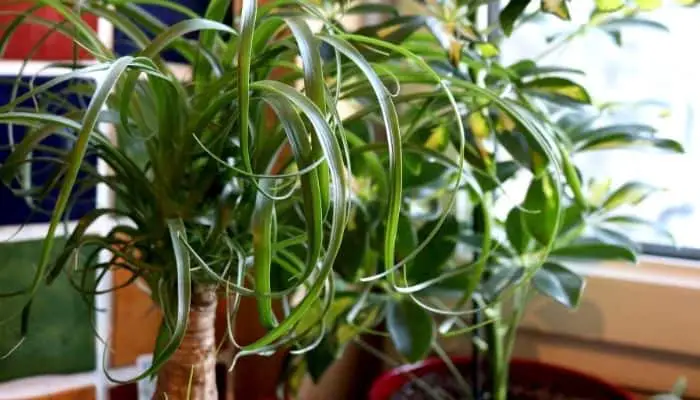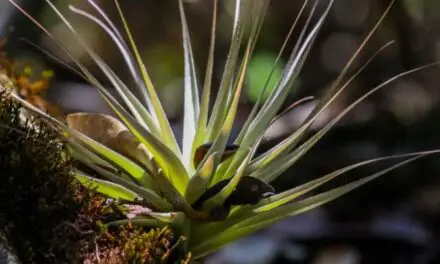Ponytail palms are lovely tropical succulents that can easily grow to be three or four feet tall indoors.
But most people like these plants to stay small and tidy, and not to outgrow the space they put them in.
Table of Contents
How To Keep A Ponytail Palm Small?

You can keep a ponytail palm small by keeping it in a small pot, not allowing it to get too much bright sunlight, and pruning it when it gets too tall.
Keep It In A Small Pot
Your ponytail palm will grow as big as its pot will allow it to. To keep it small, repot it in a small pot. This will limit the growth of the root bulb and the palm itself.
If kept in a small pot, ponytail palms are not fast growers and will need to be re-potted about once every two or three years.
When you do so, choose a pot that gives your bulb an inch of space all the way around the pot.
Plant it with well-draining succulent soil or a mixture of potting soil, perlite, and sand.
Restrict Light
The more bright light ponytail palms receive the faster they grow.
These plants like full sun but can also tolerate some shade.
They do well in full sun, bright indirect sunlight, and also lower light conditions.
If you want to slow the growth of your ponytail palm and keep it small put it somewhere where it will receive medium amounts of indirect sunlight.
Pruning
Although ponytail palms are very slow growers and do not need to be pruned regularly, they will eventually grow tall.
If your plant does start reaching for the ceiling you can prune the stems back almost to the trunk and this will reduce the size of your plant and help to keep it small.
Also Read: What Attracts Mealybugs? (And How To Stop Them)
How To Pot A Ponytail Palm
Choose a clay pot or another type of pot with good drainage.
The clay will absorb some of the moisture when you water the plant.
For potting soil, you need to pick a mix that will help your ponytail palm drain and keep it from sitting in excess water.
If you have potting soil, you can mix it with 30% perlite to create your own succulent-friendly potting mix.
You could also buy a succulent potting mix or desert soil mix.
Use a pot that gives at least one inch all the way around the stump of your palm when it is placed in the pot.
This will give it room to grow (which is needed, at least a little).
How To Repot A Ponytail Palm
To repot a ponytail palm, you will need to pick out a slightly larger pot that has good drainage.
Leave enough room for one inch of space all the way around between the sides of the pot and your ponytail palm’s trunk.
Wear your gardening gloves or use caution while you transfer the ponytail palm to the new pot.
The leaves of this plant have serrated edges and can deliver some nasty cuts.
Repot your ponytail palm every 2 or 3 years to give it more room.
If you want to keep it small, continue to choose only slightly larger but still small pots to keep it in.
Do Ponytail Palms Like To Be Root Bound?
Ponytail palms do like to be root bound and only need to be re-potted about once every 2 to 3 years.
These plants grow their roots first so whatever sized pot you put them in, they will end up root bound again before too long.
Ponytail palms like arid conditions and they use their masses of thick roots to store water.
If you keep repotting these plants into bigger pots they will grow to be enormous.
What To Do With Ponytail Palm Babies
Your ponytail palm may even give off baby offset palm plants.
You will find these at the base of your plant.
To care for your baby offshoot, you can cut it off close to the base when it gets to be around four inches tall.
Then you can pot it in its own small pot with a succulent mix.
You still need to repot your ponytail palm every 2 or 3 years to keep it healthy.
Can Ponytail Palms Take Full Sun?
Ponytail palms are one of the few tropical houseplants that can take lots of full sun.
These plants are really not that fussy about the amount of light they get.
They do well in direct sunlight and they also do well in rooms with lots of bright indirect sunlight.
They can even do okay back from the window in more shaded spots.
Just remember that the more bright light your ponytail palm gets the faster it will grow.
The amount of light it receives will also affect its color.
Ponytail palms that receive lots of strong direct sunlight will turn a lighter shade of green, while plants that are kept in more shaded areas will turn a darker green.
Do Ponytail Palms Like Humidity?
Ponytail palms are tropical succulents and do like environments that are humid.
However, they are resilient plants and can also do fine in environments with lower levels of humidity.
But these plants do tend to show signs of distress (brown tips on their leaves) when humidity levels drop to below 30%.
Does A Ponytail Palm Flower?
Ponytail palms are flowering plants but they don’t usually flower until they are at least 10 years old and they very rarely flower when kept indoors as houseplants.
These plants can sometimes flower when they are grown outdoors in warm, sunny, and humid conditions.
When ponytail palms bloom they display clusters of flowers on top of their foliage that ranges in color from creamy-white to reddish-brown.
Do I Need To Clean My Ponytail Palm
Yes, you need to clean dust from your ponytail palm at least twice a year.
Dust builds up over time and once it becomes thick enough on your plant’s leaves it can interfere with photosynthesis and stunt the plant’s growth.
It can be difficult and hazardous to wipe the dust off all the leaves of your ponytail palm.
The best thing to do is take the plant into the shower and give it a good hosing down with water that is at room temperature or slightly warmer.
Before you shower your plant use a plastic bag to cover up the pot and as much of the trunk as possible so that you are only showering the leaves and not waterlogging the soil or wetting the trunk too much.
Do I Need To Prune My Ponytail Palm?
You do not need to prune your ponytail palm because it is a very slow-growing plant.
Without pruning, the plant will eventually grow tall stems.
If you feel that the plant is eventually becoming too tall for its space, you can then prune back the stems by cutting them close to the main trunk where it will develop new shoots and begin to grow wider.
How To Care For Your Ponytail Palm
Watering
These plants like their soil to be mostly dry and they store water in their roots and trunk so they really don’t need much watering.
Overwatering is one of the biggest killers of these guys.
There are a couple of ways in which you can tell if this plant needs water or not.
One way is to squeeze the trunk and if it feels hard it means the plant is hydrated.
If the trunk feels spongy and looks as though it has shrunk, then you can water it and the trunk will plump back up after a few hours.
Another way to tell if your ponytail palm needs water is to test the soil with your finger.
If the top two inches of soil feels almost completely dry, then it’s probably safe enough to give it some water.
If your plant is suffering from a severe lack of water, its old leaves will begin to turn brown and completely dry out.
To water it, give the soil a really good soaking and let it drain in a dish then wait until the top two inches of soil are dry before watering again.
Never allow this plant to sit in water and try to avoid pouring water onto its trunk when watering it.
If water is continually poured onto the trunk of your ponytail palm it may begin to rot.
Light
These plants flourish in bright-light conditions.
They can also handle direct sunlight.
Just remember that the more bright light your plant gets the faster it will grow.
Keep in mind that your palm will go dormant between fall and spring.
During the summer months, you can keep it away from bright light and let it rest in a cooler room.
This will help to mimic the environment of a cool desert and help your plant to conserve energy.
It won’t be growing, so it doesn’t need too much moisture and you could easily overwater it.
If you think you have overwatered your ponytail palm (you’ll notice yellow leaves or the trunk will be squishy), you should let the plant drain and dry out completely before watering again.
Keep it in the bright, indirect sunlight and it will hopefully make a full recovery
Soil
Ponytail palms grow a thick root mass so it is best to use a loose, fast-draining soil mix so that it doesn’t compact around the roots too much and they can breathe easily.
A good mix to use is 70% regular planting soil and 30% perlite.
Final Thoughts
Ponytail palms are a beautiful and easy plant to grow.
And if you want to keep them small, just remember to keep them snug in their pots, restrict the amount of bright and direct sunlight they get, and prune them back when they begin to get too tall.




